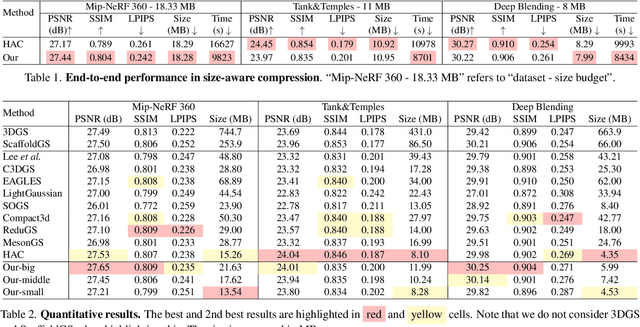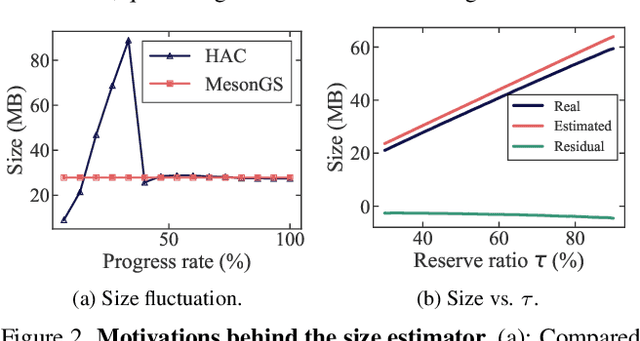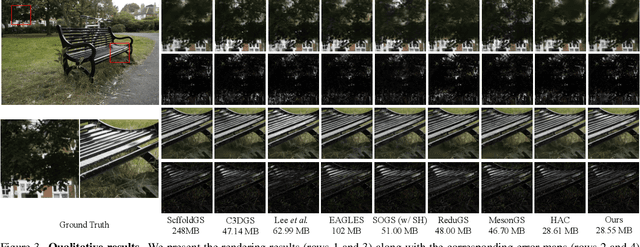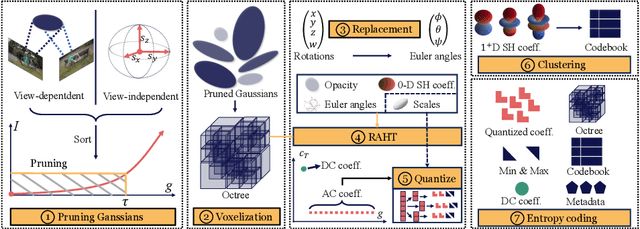Yunpeng Bai
BrepLLM: Native Boundary Representation Understanding with Large Language Models
Dec 18, 2025Abstract:Current token-sequence-based Large Language Models (LLMs) are not well-suited for directly processing 3D Boundary Representation (Brep) models that contain complex geometric and topological information. We propose BrepLLM, the first framework that enables LLMs to parse and reason over raw Brep data, bridging the modality gap between structured 3D geometry and natural language. BrepLLM employs a two-stage training pipeline: Cross-modal Alignment Pre-training and Multi-stage LLM Fine-tuning. In the first stage, an adaptive UV sampling strategy converts Breps into graphs representation with geometric and topological information. We then design a hierarchical BrepEncoder to extract features from geometry (i.e., faces and edges) and topology, producing both a single global token and a sequence of node tokens. Then we align the global token with text embeddings from a frozen CLIP text encoder (ViT-L/14) via contrastive learning. In the second stage, we integrate the pretrained BrepEncoder into an LLM. We then align its sequence of node tokens using a three-stage progressive training strategy: (1) training an MLP-based semantic mapping from Brep representation to 2D with 2D-LLM priors. (2) performing fine-tuning of the LLM. (3) designing a Mixture-of-Query Experts (MQE) to enhance geometric diversity modeling. We also construct Brep2Text, a dataset comprising 269,444 Brep-text question-answer pairs. Experiments show that BrepLLM achieves state-of-the-art (SOTA) results on 3D object classification and captioning tasks.
WorldReel: 4D Video Generation with Consistent Geometry and Motion Modeling
Dec 08, 2025Abstract:Recent video generators achieve striking photorealism, yet remain fundamentally inconsistent in 3D. We present WorldReel, a 4D video generator that is natively spatio-temporally consistent. WorldReel jointly produces RGB frames together with 4D scene representations, including pointmaps, camera trajectory, and dense flow mapping, enabling coherent geometry and appearance modeling over time. Our explicit 4D representation enforces a single underlying scene that persists across viewpoints and dynamic content, yielding videos that remain consistent even under large non-rigid motion and significant camera movement. We train WorldReel by carefully combining synthetic and real data: synthetic data providing precise 4D supervision (geometry, motion, and camera), while real videos contribute visual diversity and realism. This blend allows WorldReel to generalize to in-the-wild footage while preserving strong geometric fidelity. Extensive experiments demonstrate that WorldReel sets a new state-of-the-art for consistent video generation with dynamic scenes and moving cameras, improving metrics of geometric consistency, motion coherence, and reducing view-time artifacts over competing methods. We believe that WorldReel brings video generation closer to 4D-consistent world modeling, where agents can render, interact, and reason about scenes through a single and stable spatiotemporal representation.
Positional Encoding Field
Oct 23, 2025Abstract:Diffusion Transformers (DiTs) have emerged as the dominant architecture for visual generation, powering state-of-the-art image and video models. By representing images as patch tokens with positional encodings (PEs), DiTs combine Transformer scalability with spatial and temporal inductive biases. In this work, we revisit how DiTs organize visual content and discover that patch tokens exhibit a surprising degree of independence: even when PEs are perturbed, DiTs still produce globally coherent outputs, indicating that spatial coherence is primarily governed by PEs. Motivated by this finding, we introduce the Positional Encoding Field (PE-Field), which extends positional encodings from the 2D plane to a structured 3D field. PE-Field incorporates depth-aware encodings for volumetric reasoning and hierarchical encodings for fine-grained sub-patch control, enabling DiTs to model geometry directly in 3D space. Our PE-Field-augmented DiT achieves state-of-the-art performance on single-image novel view synthesis and generalizes to controllable spatial image editing.
Organ-Agents: Virtual Human Physiology Simulator via LLMs
Aug 20, 2025Abstract:Recent advances in large language models (LLMs) have enabled new possibilities in simulating complex physiological systems. We introduce Organ-Agents, a multi-agent framework that simulates human physiology via LLM-driven agents. Each Simulator models a specific system (e.g., cardiovascular, renal, immune). Training consists of supervised fine-tuning on system-specific time-series data, followed by reinforcement-guided coordination using dynamic reference selection and error correction. We curated data from 7,134 sepsis patients and 7,895 controls, generating high-resolution trajectories across 9 systems and 125 variables. Organ-Agents achieved high simulation accuracy on 4,509 held-out patients, with per-system MSEs <0.16 and robustness across SOFA-based severity strata. External validation on 22,689 ICU patients from two hospitals showed moderate degradation under distribution shifts with stable simulation. Organ-Agents faithfully reproduces critical multi-system events (e.g., hypotension, hyperlactatemia, hypoxemia) with coherent timing and phase progression. Evaluation by 15 critical care physicians confirmed realism and physiological plausibility (mean Likert ratings 3.9 and 3.7). Organ-Agents also enables counterfactual simulations under alternative sepsis treatment strategies, generating trajectories and APACHE II scores aligned with matched real-world patients. In downstream early warning tasks, classifiers trained on synthetic data showed minimal AUROC drops (<0.04), indicating preserved decision-relevant patterns. These results position Organ-Agents as a credible, interpretable, and generalizable digital twin for precision diagnosis, treatment simulation, and hypothesis testing in critical care.
BRepFormer: Transformer-Based B-rep Geometric Feature Recognition
Apr 10, 2025



Abstract:Recognizing geometric features on B-rep models is a cornerstone technique for multimedia content-based retrieval and has been widely applied in intelligent manufacturing. However, previous research often merely focused on Machining Feature Recognition (MFR), falling short in effectively capturing the intricate topological and geometric characteristics of complex geometry features. In this paper, we propose BRepFormer, a novel transformer-based model to recognize both machining feature and complex CAD models' features. BRepFormer encodes and fuses the geometric and topological features of the models. Afterwards, BRepFormer utilizes a transformer architecture for feature propagation and a recognition head to identify geometry features. During each iteration of the transformer, we incorporate a bias that combines edge features and topology features to reinforce geometric constraints on each face. In addition, we also proposed a dataset named Complex B-rep Feature Dataset (CBF), comprising 20,000 B-rep models. By covering more complex B-rep models, it is better aligned with industrial applications. The experimental results demonstrate that BRepFormer achieves state-of-the-art accuracy on the MFInstSeg, MFTRCAD, and our CBF datasets.
DragScene: Interactive 3D Scene Editing with Single-view Drag Instructions
Dec 18, 2024



Abstract:3D editing has shown remarkable capability in editing scenes based on various instructions. However, existing methods struggle with achieving intuitive, localized editing, such as selectively making flowers blossom. Drag-style editing has shown exceptional capability to edit images with direct manipulation instead of ambiguous text commands. Nevertheless, extending drag-based editing to 3D scenes presents substantial challenges due to multi-view inconsistency. To this end, we introduce DragScene, a framework that integrates drag-style editing with diverse 3D representations. First, latent optimization is performed on a reference view to generate 2D edits based on user instructions. Subsequently, coarse 3D clues are reconstructed from the reference view using a point-based representation to capture the geometric details of the edits. The latent representation of the edited view is then mapped to these 3D clues, guiding the latent optimization of other views. This process ensures that edits are propagated seamlessly across multiple views, maintaining multi-view consistency. Finally, the target 3D scene is reconstructed from the edited multi-view images. Extensive experiments demonstrate that DragScene facilitates precise and flexible drag-style editing of 3D scenes, supporting broad applicability across diverse 3D representations.
SizeGS: Size-aware Compression of 3D Gaussians with Hierarchical Mixed Precision Quantization
Dec 08, 2024



Abstract:Effective compression technology is crucial for 3DGS to adapt to varying storage and transmission conditions. However, existing methods fail to address size constraints while maintaining optimal quality. In this paper, we introduce SizeGS, a framework that compresses 3DGS within a specified size budget while optimizing visual quality. We start with a size estimator to establish a clear relationship between file size and hyperparameters. Leveraging this estimator, we incorporate mixed precision quantization (MPQ) into 3DGS attributes, structuring MPQ in two hierarchical level -- inter-attribute and intra-attribute -- to optimize visual quality under the size constraint. At the inter-attribute level, we assign bit-widths to each attribute channel by formulating the combinatorial optimization as a 0-1 integer linear program, which can be efficiently solved. At the intra-attribute level, we divide each attribute channel into blocks of vectors, quantizing each vector based on the optimal bit-width derived at the inter-attribute level. Dynamic programming determines block lengths. Using the size estimator and MPQ, we develop a calibrated algorithm to identify optimal hyperparameters in just 10 minutes, achieving a 1.69$\times$ efficiency increase with quality comparable to state-of-the-art methods.
FiffDepth: Feed-forward Transformation of Diffusion-Based Generators for Detailed Depth Estimation
Dec 01, 2024



Abstract:Monocular Depth Estimation (MDE) is essential for applications like 3D scene reconstruction, autonomous navigation, and AI content creation. However, robust MDE remains challenging due to noisy real-world data and distribution gaps in synthetic datasets. Existing methods often struggle with low efficiency, reduced accuracy, and lack of detail. To address this, we propose an efficient approach for leveraging diffusion priors and introduce FiffDepth, a framework that transforms diffusion-based image generators into a feedforward architecture for detailed depth estimation. By preserving key generative features and integrating the strong generalization capabilities of models like dinov2, FiffDepth achieves enhanced accuracy, stability, and fine-grained detail, offering a significant improvement in MDE performance across diverse real-world scenarios.
MesonGS: Post-training Compression of 3D Gaussians via Efficient Attribute Transformation
Sep 15, 2024



Abstract:3D Gaussian Splatting demonstrates excellent quality and speed in novel view synthesis. Nevertheless, the huge file size of the 3D Gaussians presents challenges for transmission and storage. Current works design compact models to replace the substantial volume and attributes of 3D Gaussians, along with intensive training to distill information. These endeavors demand considerable training time, presenting formidable hurdles for practical deployment. To this end, we propose MesonGS, a codec for post-training compression of 3D Gaussians. Initially, we introduce a measurement criterion that considers both view-dependent and view-independent factors to assess the impact of each Gaussian point on the rendering output, enabling the removal of insignificant points. Subsequently, we decrease the entropy of attributes through two transformations that complement subsequent entropy coding techniques to enhance the file compression rate. More specifically, we first replace rotation quaternions with Euler angles; then, we apply region adaptive hierarchical transform to key attributes to reduce entropy. Lastly, we adopt finer-grained quantization to avoid excessive information loss. Moreover, a well-crafted finetune scheme is devised to restore quality. Extensive experiments demonstrate that MesonGS significantly reduces the size of 3D Gaussians while preserving competitive quality.
Tuning-Free Visual Customization via View Iterative Self-Attention Control
Jun 11, 2024



Abstract:Fine-Tuning Diffusion Models enable a wide range of personalized generation and editing applications on diverse visual modalities. While Low-Rank Adaptation (LoRA) accelerates the fine-tuning process, it still requires multiple reference images and time-consuming training, which constrains its scalability for large-scale and real-time applications. In this paper, we propose \textit{View Iterative Self-Attention Control (VisCtrl)} to tackle this challenge. Specifically, VisCtrl is a training-free method that injects the appearance and structure of a user-specified subject into another subject in the target image, unlike previous approaches that require fine-tuning the model. Initially, we obtain the initial noise for both the reference and target images through DDIM inversion. Then, during the denoising phase, features from the reference image are injected into the target image via the self-attention mechanism. Notably, by iteratively performing this feature injection process, we ensure that the reference image features are gradually integrated into the target image. This approach results in consistent and harmonious editing with only one reference image in a few denoising steps. Moreover, benefiting from our plug-and-play architecture design and the proposed Feature Gradual Sampling strategy for multi-view editing, our method can be easily extended to edit in complex visual domains. Extensive experiments show the efficacy of VisCtrl across a spectrum of tasks, including personalized editing of images, videos, and 3D scenes.
 Add to Chrome
Add to Chrome Add to Firefox
Add to Firefox Add to Edge
Add to Edge